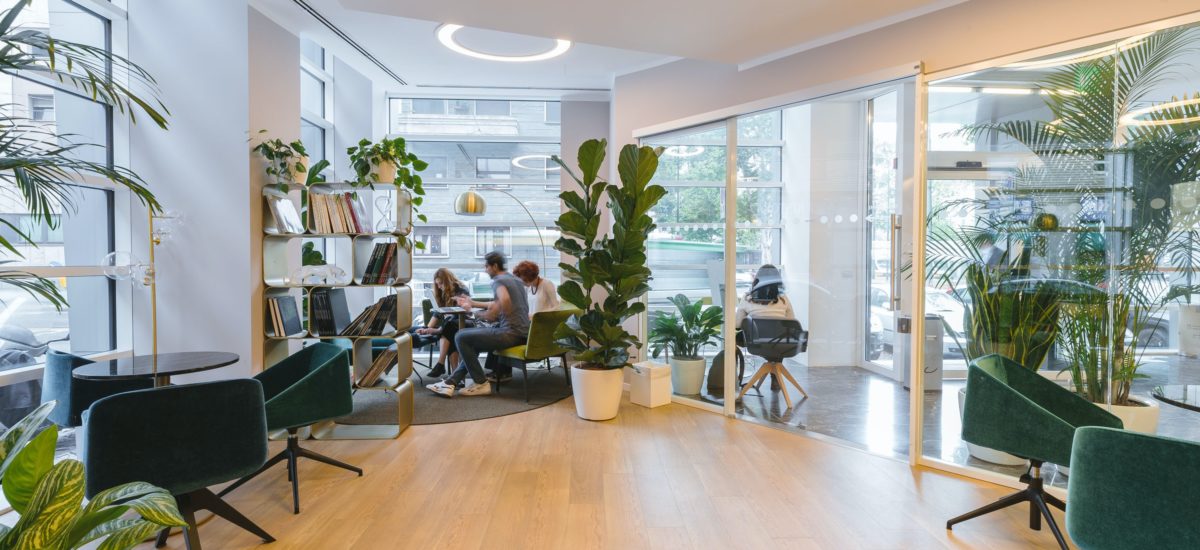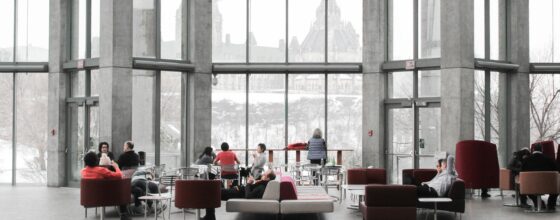It’s Time To Redesign Your Corporate HQ

Corporate office space is downsizing, and it makes sense. The biggest work from home experiment in the world is coming to an end and we’ve discovered that people don’t have to physically come into the office to produce good work.
Corporate giants have sent their employees home indefinitely and we’re seeing companies of all sizes proclaim their new remote strategies in the press. This spring, HSBC announced that their employees were going to be a “permanent agile workforce.” In addition, the company is downsizing office space by 40% globally.*
This means tremendous cost saving to the corporations as they send workers home and close down, or downsize, office space. But there is another side to this coin that must be factored into the equation—the human cost.
The WFH Burden
Working from home, for starters, is a privilege. Not everyone has space in their home for a “home office.” Rarely is that home office sound proof, ergonomic and ideal for work. Now we have humans working from home with their children and trying to homeschool. For women in particular this is a burden not a benefit.
Not to mention that working from home is quite often working in isolation for another segment of the population. Depression is simply out of control. Depression, which can lead to an inability to work at all, is not helped by working at home, alone.
The pandemic has set women back. The pandemic has set mental health back. The pandemic has challenged work/life balance. We will need spaces outside our homes to get work done.
The Office is Not Dead.
Saying the office is dead is like saying restaurants are dead. We all have kitchens in our homes, but we still go out to eat.
As corporations shrink their space, they need to reinvent the space they keep. Independent work will likely be done closer to home in a third space, such as a coworking space, flexible workspace or coffee shop, or in their home office.
Work has changed so your office design needs to evolve.
We have learned that people not only miss the water cooler conversations, they crave them. You should be providing space for social, serendipitous interaction. I’m not a fan of providing alcohol (a depressant) in a work setting, but you can have a coffee bar, juice bar or social bar for your employees.
Consider the type of seating you enjoy when you’re at home, in a restaurant or in a hotel lobby. Can you provide that in your space? Maybe you need more soft seating, booths and sofas. Do you have a view people can soak in?
Everyone needs to get on phone calls or Zoom. Do you have phone booths? That phone booth will need ventilation, light, power and a seat. We all need to take private calls at work, so provide a space for that.
What about a space for a project team? Do you have spaces that make this experience lovely? Yes, lovely is the goal—not good enough.
What if you had a room with an amazing camera, flattering lighting and technology that just worked? Speaking of technology, are you investing in systems that make the experience better and touchless? You should be.
When we come into a space, we want to clearly understand where to go. Wayfinding is super important. We want to seamlessly access the internet and find our place to work. If we want to book a room for a meeting or to collaborate, that should be easy and intuitive.
I believe that offices will primarily be used for purpose-driven meetings, social events and training, and that your offices should reflect that new purpose. Instead of simply calling everything a meeting room, what about collaboration space, upskilling, sensory deprivation, team building, Zoom rooms or privacy room (We can all use a little down time.).
Healthy Buildings, Healthy Humans.
How are you addressing the health of your building? If you haven’t read Healthy Buildings by Joseph G. Allen and John D. Macober and The Healthy Workplace Nudge by Rex Miller, you should. These two books will give you all the data you need to overrule the inevitable questions about the cost of providing better space.
Humans are basically house plants. We need the right light, hydration and environment to thrive. You and your employees can be optimized in space with better air, light and design. If you don’t know about WELL Building Institute, take the opportunity to educate yourself.
Your employees are going to start asking you questions about the air flow, air quality and general health of the space you expect them to work in.
It would be impossible for us to have a conversation about design, the future of work and offices without talking about COVID.
We all need to continue to be vigilant about cleaning. We also need to understand the products we’re using to clean our spaces. Are they non-toxic? Sustainable?
We need to understand the health of our air systems. Do we need to invest in better duct work? Air filtrations systems? Upgrade the heating or cooling systems? Utilize UV lights?
Getting Started
We’ve covered a lot, so let’s break it down into a few manageable steps you can get started on today:
Here are three things you can do now to prepare for a redesign:
- Survey your employees to find out how they’re doing and where they want to work.
- Hire experts to help you re-imagine and re-design your space (Deco Group can help. If we can’t personally handle it we’ll connect you with friends we know can.).
- Investigate the health of your building and start investing in change.
We’ve given you lots of food for thought. Most importantly, don’t waste a crisis. Use this as an opportunity and an indication that it’s time to make some sweeping changes.
To learn more about our industry join the GCUC community where you can plug in 24/7/365. To connect with the author or learn more about Liz Elam simply click here for her Linkedin profile.






